
Melaleuca viminalis, commonly known as weeping bottlebrush, or creek bottlebrush is a plant in the myrtle family, Myrtaceae and is endemic to New South Wales, Queensland and Western Australia. It is a multi-trunked, large shrub or tree with hard bark, often pendulous foliage and large numbers of bright red bottlebrush flowers in spring and summer. It is possibly the most commonly cultivated melaleuca in gardens and its cultivars are often grown in many countries.
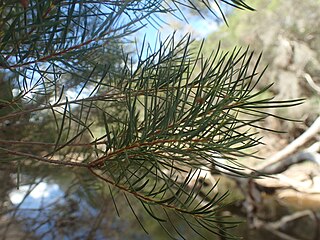
Melaleuca trichostachya is a plant in the myrtle family, Myrtaceae and is native to inland northern New South Wales, Queensland, South Australia and the Northern Territory in Australia. It is a small tree, similar to the commonly cultivated Melaleuca styphelioides, with its prickly foliage and fluffy spikes of white or cream flowers but there are differences in the leaf arrangement and fruiting capsules.

Melaleuca pityoides, commonly known as alpine bottlebrush, is a plant in the family Myrtaceae, and is endemic to the higher areas of south eastern Australia. Some Australian state herbaria continue to use the name Callistemon pityoides. It is a shrub, often occurring in dense thickets, with hard bark, silvery-grey new growth, almost cylindrical leaves and spikes of flowers that are usually a shade of yellow.

Melaleuca williamsii is a plant in the myrtle family, Myrtaceae and is endemic to an area between north-eastern New South Wales and south eastern Queensland in Australia. It is a distinctive shrub with stiff branches, silvery new growth, prickly leaves and spikes of purple flowers in late spring. It is classified as a vulnerable species under the Australian Government Endangered Species Protection Act.
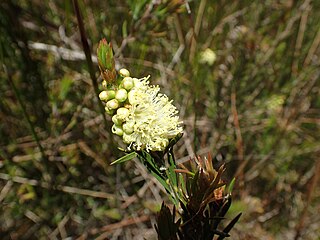
Melaleuca paludicola, commonly known as river bottlebrush, is a plant in the myrtle family Myrtaceae, and is endemic to eastern Australia. It is a shrub or small tree with flexible, often drooping branches, pinkish new growth and spikes of cream, pale yellow, or sometimes pink flowers in summer.

Melaleuca recurva, commonly known as Tinaroo bottlebrush, is a plant in the myrtle family, Myrtaceae and is endemic to higher areas of far northern Queensland in Australia.. It is a shrub with spikes of red flowers tipped with yellow in most months of the year and which often has leaves with their edges curled under.

Melaleuca faucicola commonly known as desert bottlebrush, is a plant in the myrtle family, Myrtaceae and is endemic to the Northern Territory in Australia. It is a shrub or small tree growing only in protected gorges in the ranges of Central Australia such as the Petermann Ranges and has red, cream or white spikes of flowers.
Melaleuca clarksonii, commonly known as Alice River bottlebrush, is a plant in the myrtle family, Myrtaceae and is endemic to Cape York Peninsula in Queensland, Australia. It is similar to Melaleuca cajuputi and Melaleuca leucadendra with its broad leaves and spikes of creamy-coloured flowers but is distinguished from them by its (usually) hard, fibrous bark.
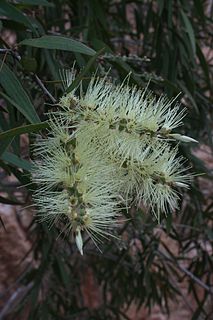
Melaleuca fluviatilis is a plant in the myrtle family, Myrtaceae and is endemic to northern Queensland in Australia. It is a tree with papery bark, narrow leaves and spikes of white or creamy-coloured flowers, usually growing along streams and rivers. It is common in tropical areas and is sometimes confused with Melaleuca argentea although it lacks that species' silvery foliage.

Melaleuca lophocoracorum is a plant in the myrtle family Myrtaceae and is endemic to a small area in the Ravenshoe State Forest, near Ravenshoe in Queensland. It is a newly described (2013) species of shrub or small tree with twisted leaves and spikes of cream-coloured flowers in summer. It is similar to Melaleuca squamophloia and Melaleuca styphelioides.

Melaleuca flammea, commonly known as tapering-leaved bottlebrush, is a plant in the myrtle family, Myrtaceae and is endemic to New South Wales and Queensland in Australia. It is a shrub with broad, lance-shaped leaves which have wavy edges and taper gradually to a fine point. In spring it has typical bottlebrush flowers whose fiery colour gives the species its name.
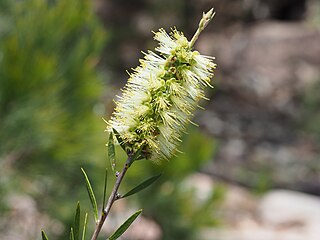
Melaleuca flavovirens, commonly known as green bottlebrush is a plant in the myrtle family, Myrtaceae and is endemic to a small area near the New South Wales–Queensland border in Australia. It is a stiff shrub, distinguished by its silvery new growth and spikes of greenish flowers with yellow tips.
Melaleuca hemisticta, commonly known as Mount Wheeler bottlebrush is a plant in the myrtle family, Myrtaceae and is endemic to coastal areas of Queensland. It is a tall, bushy shrub with dark green leaves and red flowers spikes tipped with yellow.
Melaleuca lazaridis is a plant in the myrtle family, Myrtaceae and is endemic to the Blackdown Tableland National Park in Queensland.. It is a shrub with dark green leaves and red flowers spikes tipped with yellow.
Melaleuca montis-zamia is a plant in the myrtle family, Myrtaceae and is endemic to the Springsure district in Queensland, Australia. It is a shrub with red bottlebrush flowers.
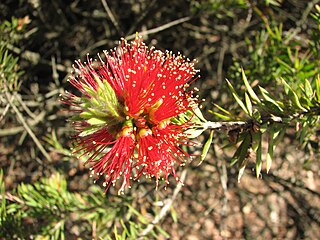
Melaleuca pearsonii, commonly known as Blackdown bottlebrush, is a plant in the myrtle family, Myrtaceae and is endemic to Queensland in Australia. It is a small, spreading but compact shrub with hard bark, soft foliage and profuse spikes of bottlebrush flowers in spring and summer.
Melaleuca phratra is a plant in the myrtle family, Myrtaceae and is endemic to Queensland in Australia. It is a large shrub similar to Melaleuca paludicola but has flower spikes that are a shade of pink.
Melaleuca quercina, commonly known as Oakey bottlebrush is a plant in the myrtle family, Myrtaceae and is endemic to a small area of Queensland in Australia. It is small tree with dark, corky bark and spikes of yellow, cream or pink bottlebrush flowers in spring and summer.

Melaleuca serpentina is a plant in the myrtle family, Myrtaceae and is endemic to the Barraba district in Australia. It is a shrub with yellow or creamy-green bottlebrush flowers. It is similar to Melaleuca citrina but can be distinguished from that species by its flower colour and its shorter stamens.

Melaleuca shiressii is a plant in the myrtle family, Myrtaceae and is endemic to a small area in New South Wales in Australia. It is rare shrub or small tree with pale, papery bark, sharp-pointed leaves and spikes of white to pale cream bottlebrush flowers in spring and summer.

















